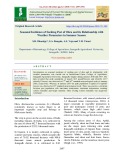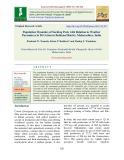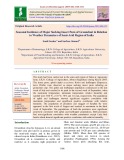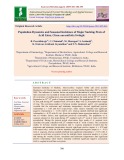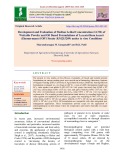
Sucking pests and temperature
-
During the investigation sucking pest viz; white fly and jassid were appeared in 33 standard meteorological week and maximum population of whitefly (0.60 per plant) and jassid (0.40 per plant) was recorded in 37th SMW. Correlation with sucking pest (whitefly and jassid) population and meteorological parameters was found positive non significant association with evening relative humidity and minimum temperature but negative correlation with maximum temperature, morning relative humidity and rainfall.
 8p
8p  caygaocaolon11
caygaocaolon11
 21-04-2021
21-04-2021
 11
11
 1
1
 Download
Download
-
Investigation on seasonal incidence of sucking pest of okra and its relationship with weather parameters was carried out at Instructional Farm, College of Agriculture, Junagadh Agricultural University, Junagadh, Gujarat during summer 2016 and 2017. The data revealed that peak population of jassid (16.1 jassid/3leaves) and whitefly (15.7 whitefly/3 leaves) was observed at 17th and 16th standard meteorological week of summer 2016, respectively. Whereas, in summer 2017 the peak population of aphid (17.8 aphid/3 leaves) was observed at 16th standard meteorological week.
 8p
8p  gaocaolon5
gaocaolon5
 14-06-2020
14-06-2020
 11
11
 1
1
 Download
Download
-
Seasonal incidence of different sucking pests of chilli viz., thrips (Scirtothrips dorsalis Hood), mites (Polyphagotarsonemus latus Banks), Aphid (Aphis gossypii Glov.), Whitefly (Bemesia tabaci Genn.) and Jassids (Amrsca bigutula bigutula) and natural enemies like Coccinellids and spiders were worked out in the present study during 2016 at District Seed Farm (AB Block) of Bidhan Chandra Krishi Viswavidyalaya located at Kalyani, Nadia, West Bengal. Peak population of thrips was recorded to be in 18th standard week i.e. 12.
 13p
13p  angicungduoc5
angicungduoc5
 12-06-2020
12-06-2020
 20
20
 0
0
 Download
Download
-
The population dynamics of sucking pests Bt cotton along with their correlation with weather factors were studied during 2008-2013 in five talukas of Buldana district, Maharashtra. According to five year average data the maximum aphid population (43.56 per cent) was recorded in 33rd meteorological week whereas jassid population were reached maximum of 4.42 jassid in 37th meteorological week.
 7p
7p  trinhthamhodang4
trinhthamhodang4
 22-03-2020
22-03-2020
 7
7
 2
2
 Download
Download
-
The study had been carried out in the semi-arid region of India at Agronomy farm, S.K.N. College of Agriculture, Jobner (Rajasthan) during Kharif 2018. The insect pests, aphid (Aphis craccivora Koch) and leafhopper (Empoasca kerri Pruthi) were observed as major sucking insect pests infesting on groundnut crop. The aphid and leafhopper population commenced in the last week of July and reached to its peak in the second week of September, when the maximum temperature, minimum temperature, relative humidity and rainfall were 30.0 oC, 21.0 oC, 78% and 1.6 mm, respectively.
 6p
6p  cothumenhmong3
cothumenhmong3
 22-02-2020
22-02-2020
 16
16
 1
1
 Download
Download
-
Seasonal incidence of blackfly, Aleurocanthus woglumi Ashby and citrus psyllids Diaphorina citri Kuwayama were studied on acid lime during September 2017 to August 2018. The influence of weather factors on population fluctuation of sucking pests in acid lime ecosystem was recorded at weekly intervals in fixed location. The study revealed that the occurrence of sucking pests was noticed throughout the study period 36th (1st week of September) to 35th (4th week of August) standard weeks. The population of D. citri attained its first peak during 19th standard week (1stweek of May) with 23.
 8p
8p  quenchua2
quenchua2
 16-12-2019
16-12-2019
 8
8
 0
0
 Download
Download
-
The present in vitro studies on bio-efficacy of granular, oil based and wettable powder formulations on various sucking pests were carried out at Entomology laboratory, Institute of Organic Farming (IOF), University of Agricultural Sciences, Dharwad. Among different formulations evaluated viz., rice bran oil (60 %) + corn oil (40%) formulation found least LC50 value against corn aphids (0.182 x106 cfu / ml), grape vine mealy bug (0.560 x 106 cfu / ml), cotton thrips (0.591 x 106 cfu / ml), and guava whitefly (0.942 x 106 cfu / ml). The olive oil formulation recorded least LC50 value 0.
 10p
10p  cothumenhmong1
cothumenhmong1
 08-12-2019
08-12-2019
 9
9
 0
0
 Download
Download
CHỦ ĐỀ BẠN MUỐN TÌM










